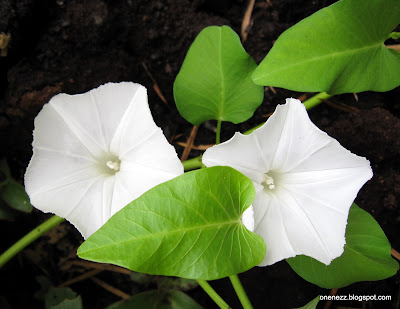Do you have days when you have just posted something and felt that you have 3 more interesting topics that you wish to blog about?
Do you experience days where no topic nor photos seem appropriate or good enough to be posted?
When one is constipated, usually a high fiber diet with lots of water will get things moving again.
With blogging constipation, I decided that Water Spinach may be the solution.
Water Spinach is a creeping vine.
To the Chinese, it is called Ong Choy.
In Malaysia, we call it Kangkung.
It is also known as Water Morning Glory or Water Convolvulus.
It's scientific name is Ipomoea Aquatica.
I was hoping to show you some pink water spinach flowers but today there are only white ones.
This one reminds me of a rising star.
Interestingly, giant mushrooms grew amongst the water spinach.
But the colours for this post remain green and white and I thought may be rather boring.
A butterfly tried to liven up the situation but did not brighten up the colours.
This is one of the many lovely seed pods.
The Water Spinach leaves were narrow and elongated when I grew them last year as food for a turtle.
Eventually the new leaves became heart-shaped.
The stink bug is a pest that suck the sap of the leaves.
This tiny metallic green fly prey on smaller insects.
Do you see a minute black spot on the water spinach leaf above?
I believe it is a black lady beetle that feeds on whitefly eggs, scale and spider mites.
It hopped away before I had a chance to focus on it.
Just when I gave up about colours for my Water Spinach topic, this little butterfly came over to rest on its leaf.
I suspect these butterflies prefer the nectar of the Basil flower more than those from the Water Spinach but one of them must heard me calling out for colours.
Thanks to Autumn Belle, these butterflies are called Cycad Blue.
What do you do when you have blogging constipation?
Would it be Wordless?






































